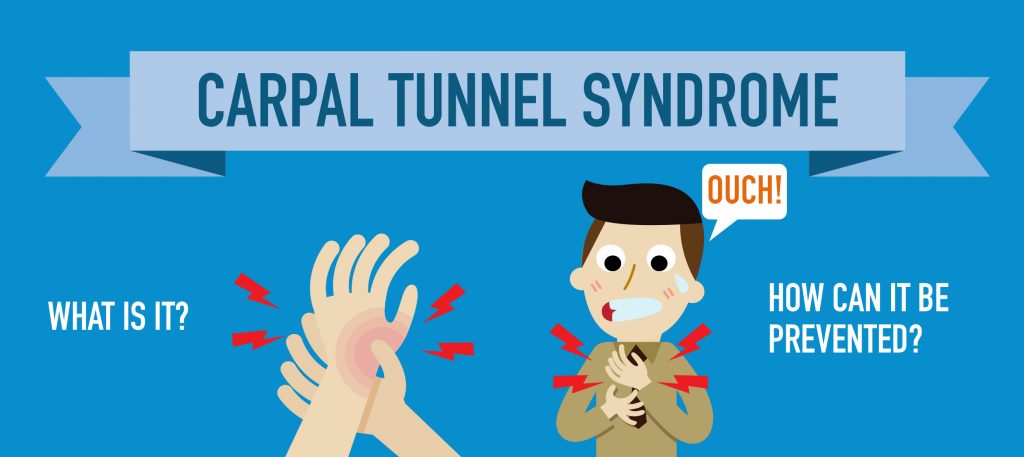WHAT IS CARPAL TUNNEL SYNDROME and WHAT CAN BE DONE ABOUT IT If diagnosed by your doctor or physio and treated early, the symptoms of Carpal Tunnel Syndrome can often be relieved without surgery. If your Carpal Tunnel Syndrome diagnosis is uncertain, or symptoms are mild, your doctor will recommend non-surgical treatment first. This will include physiotherapy and rehabilitation exercises.
Non-surgical rehab & physio treatments for Carpal Tunnel Syndrome include:
Bracing or splinting. Wearing a brace or splint at night will keep you from bending your wrist while you sleep. Keeping your wrist in a straight or neutral position reduces pressure on the nerve in the carpal tunnel. It may also help to wear a splint during the day when doing activities that aggravate your symptoms. Non-steroidal anti-inflammatory drugs (NSAIDs). Medications such as ibuprofen and naproxen can help relieve pain and inflammation. Activity changes. Symptoms often occur when your hand and wrist are in the same position for too long – particularly when your wrist is flexed or extended. If your job or recreational activities aggravate your symptoms, changing or modifying these activities can help slow or stop the progression of the disease. In some cases, this may involve making changes to your worksite or work station. Your physical therapist can help with advice on the correct workspace and computer set-up. Nerve gliding rehabilitation exercises. You may benefit from exercises that help the median nerve move more freely within the confines of the carpal tunnel. Specific exercises may be recommended by your physical therapist. Steroid injections. Corticosteroid, or cortisone, is a powerful anti-inflammatory agent that can be injected into the carpal tunnel. Although these injections often relieve painful symptoms or help to calm a are up of symptoms, their effect is sometimes only temporary. A cortisone injection may also be used by your doctor to help diagnose your carpal tunnel syndrome. Physiotherapy treatment. Treatments can include mobilising the carpal bones and stretching the carpal tissues to open up space. Soft tissue mobilisation / massage can relieve pain and tension in the muscles of the hand and forearm. Mobilisation and manipulation of the bones of the neck and upper back cervical have been beneficial in treating CTS releasing the nerves from their origin in the neck. Strengthening exercises for grip, pinch and forearm flexor/extensor muscles is crucial in treating and preventing CTS.
CARPAL TUNNEL SYNDROME PREVENTION AND REHABILITATION EXERCISES
SURGICAL MANAGEMENT of CARPAL TUNNEL SYNDROME
If other treatments are unsuccessful, surgery can help to correct a condition that has been prevalent for years at a time. If nerve damage has occurred, surgery can help to correct the problem. Surgery involves cutting the ligament that forms the roof of the carpal tunnel. In doing so, the pressure on the median nerve is relieved, which will help to ease the symptoms associated with CTS.
HOW CAN CTS BE PREVENTED?
If you use a computer keyboard, there are several things you can do to lower your chances of developing CTS. Proper seating is crucial to good ergonomics. The height of your seat and the position of your backrest should be adjustable. The chair should be on wheels so you can move it easily. Keyboard Position If your keyboard is positioned properly your wrists should be able to rest comfortably on the table in front of it. Some keyboards are very thick or deep and they require you to bend your hands uncomfortably upward to reach the keys. If so, it will help to place a raised wrist rest on the table in front of the keyboard. A keyboard that requires you to bend your wrists is a common cause of CTS among computer users. Chair and table height. With your hands resting comfortably at the keyboard and your upper arms vertical, measure the angle between your forearm and your upper arm (the elbow angle). If it is less than 90 degrees, raise the seat of your chair. If the angle is greater than 90 degrees, lower the seat. Try to hold your elbows close to your sides to help minimise “ulnar displacement” the sideways bending of the wrist (as when reaching for the “Z” key). Armrests on the chair, though optional, are often helpful. Take short breaks You need very little recovery time between keystrokes to cool and lubricate the flexor tendons. If you type constantly, however, the need for recovery builds. In addition, working with your hands bent upward at the wrists or frequently bending your wrists sideways heightens the friction within the carpal tunnel. It takes longer to recover from these motions. Working under stress (deadline pressure, anger, or other anxiety) can make matters even worse. Take regular short breaks to relieve repetitive stress. Variety is the key. CTS occurs most frequently when motions are not only repetitious but are also kept up for hours at a time. If you use a keyboard, structure your workdays to include a mix of activities that require different physical actions each hour. Physio & massage Physical therapy and massage therapy can both assist in helping you to prevent and treat this stubborn condition and the earlier you tackle it, the more quickly and effectively you’ll be able to treat it.
